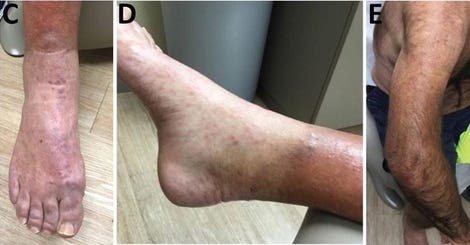Doctors in Florida are sounding caution about one of the world’s oldest known ailments, leprosy. In a recent report, they detail a local case of the bacterial disease with no recent travel history or other clear risk factors. The case and others suggest that leprosy is spreading routinely in Central Florida and has become endemic in the area, the authors say, but there’s no clear answer yet as to how and why.
The report was published in the August issue of Emerging Infectious Diseases, a journal run by the Centers for Disease Control and Prevention. According to the paper, the case involves a 54-year-old man who resides in Central Florida. Sometime last year, the man visited a dermatology clinic for help with a painful rash that had started in his legs and arms but eventually spread to his trunk and face. Testing soon confirmed that the man had contracted leprosy, a chronic infection caused by Mycobacterium leprae bacteria (it’s also a relative of the bacteria behind tuberculosis)

Leprosy, also known as Hansen’s disease, has been known about since biblical times. Much like viruses, leprosy bacteria invade and hijack our cells to make more of themselves. It can take years for symptoms to appear following infection, which includes pale lesions and sores. If left untreated, the infection can gradually destroy nerve and eye cells as well, causing problems like blindness and permanently disfigured limbs.
The disease is no longer the global scourge it once was, thanks to the availability of antibiotics and improved sanitation. But it is an issue in some countries, with more than 200,000 cases reported annually worldwide, according to the World Health Organization. In the U.S., newly reported cases have continued to remain low, with most involving people who likely caught the disease somewhere else but were diagnosed here. But that’s started to change in Florida more recently.
In this latest case, for instance, the man reported no travel history nor exposure to people who might have previously lived in endemic areas, such as migrants to the U.S. And between 2015 to 2020, the authors note, roughly a third of leprosy cases in Florida were likely also caught locally. At the same time, fewer and fewer cases have involved people born outside the U.S.
These trends, the authors wrote, “contribute to rising evidence that leprosy has become endemic in the southeastern United States.”
Strangely enough, given its fearsome reputation, leprosy is usually very hard to catch. Person-to-person transmission tends to require prolonged close contact with respiratory droplets, and as much as 95% of people are thought to be naturally immune to infection. More recently, some cases of leprosy in the southern U.S. have been linked to contact with nine-banded armadillos, which can carry the bacteria, suggesting that zoonotic transmission is playing a role in the increased spread of the disease.
That said, the risk of armadillo-to-human transmission of leprosy seems to be low as well. The man in this current case also didn’t report any exposure to armadillos, and many cases in the area have similarly lacked any clear explanation as to how they caught it.
The authors say that more research is needed to understand how and why leprosy has gained a foothold in Florida. They point out that their patient and many other cases have reported spending lots of time outdoors, which could suggest a possible environmental source of the bacteria. They also advise that doctors outside Florida who come across leprosy cases in their area should start to consider recent travel history to the state as a possible explanation.
As for the man himself, he was given a three-drug combination of antibiotics, which is the standard treatment. Leprosy remains reliably curable, but treatment can’t reverse the permanent debilitating effects of late-stage illness, so it’s best to diagnose it as early as possible.
